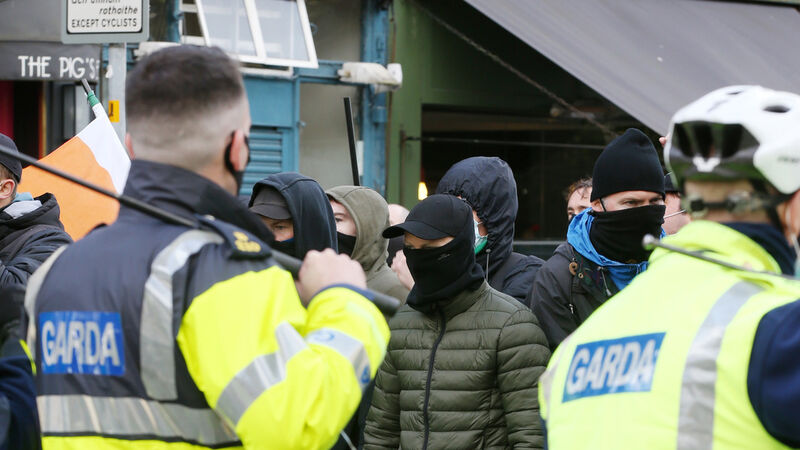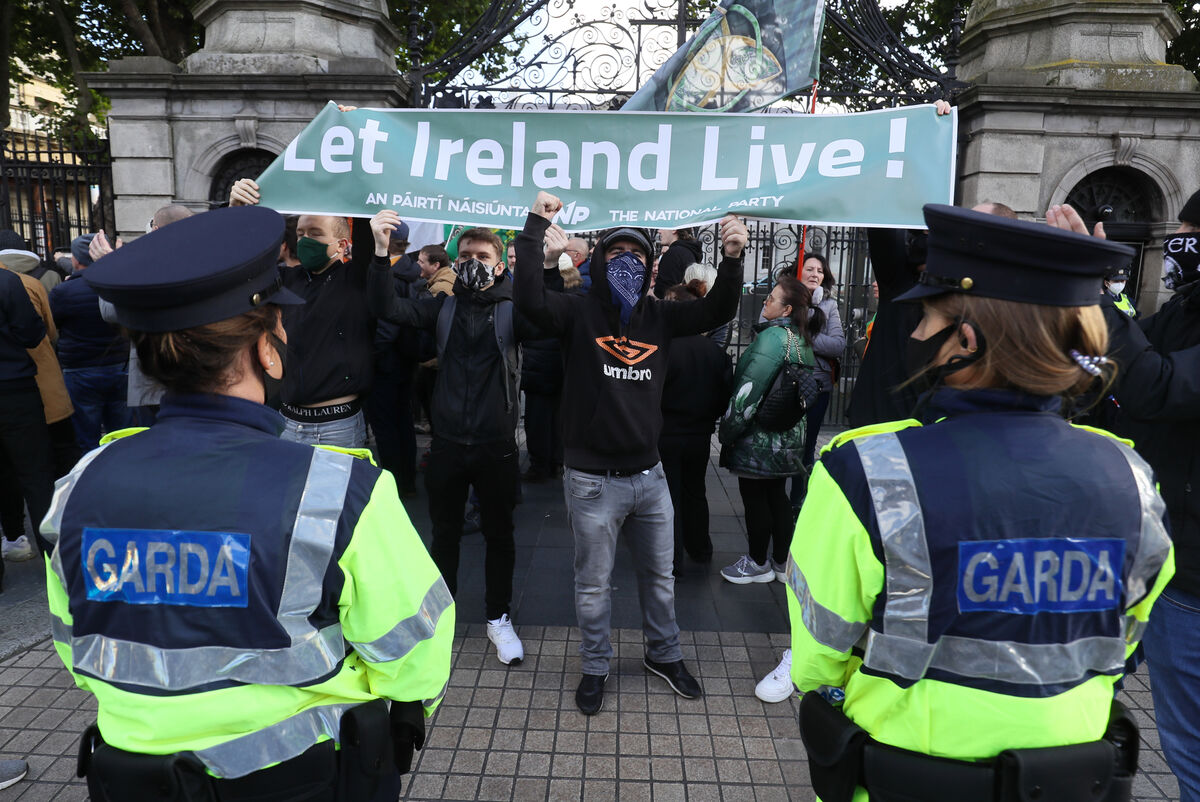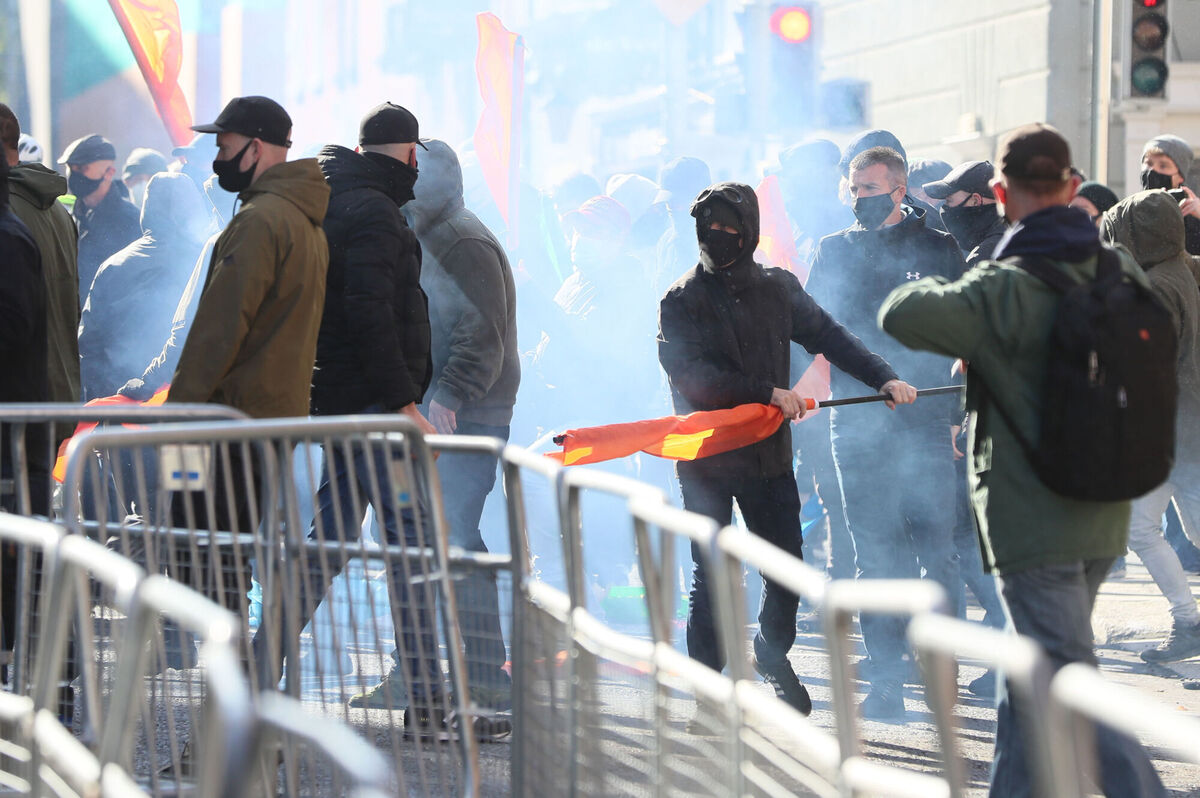Michael Clifford: Twitter mob calling for 'good' violence need to show some cop on

Suppressing opposition through violence on the streets of a democratic country is an inherently fascist action. Picture: Sam Boal /RollingNews.ie
There are intelligent people out there who believe this country is fast heading to the kind of place Germany found itself in circa 1930.
According to what these people posted on social media to me during the week, fascism is a real and present danger. Only if suppressed violently can it be properly eradicated.
Last Saturday, I wrote about a gathering of the National Party outside Leinster House. The National Party is an anti-immigrant entity that is described as fascist by people who monitor its activities. There were maybe 60 or 70 people there. Around 100 gardaí were also in attendance to police the event.
And then just after 1pm, a group marched up Molesworth St in a step full of intent. This was the opposition Anti Fascist Action (AFA). A large cohort of these people also describe themselves as republicans.
The AFA people and their allies numbered well over 100 strong. They moved quickly, attempting to breach the barriers separating them from the nationalists. A burst of violence between the two sides ensued.
The gardaí restored order relatively quickly. Following that, there were a few running battles and the odd missile thrown. If the gardaí had not been present, serious injury or death would have been a real possibility.
I wrote a sketch of what I’d witnessed for the . Two groups of thugs squaring up to each other, spitting bile and hate. This description drew an equivalence between the two sides.
The similarities were obvious. Both sides included a preponderance of young men, faces covered in scarves, baseball hats, and displaying an air of menace.
Both advertised nationalism through use of the Tricolour and various pieces of apparel referencing 1916. Both were obviously intent on violence. Both were hostile to media people.
Among the various definitions of fascism is “authoritarian, ultra-nationalist, intent on violent suppression of opposition”.
This description could be applied to both entities last Saturday.

Of course, there are differences in their ostensible political philosophies. The right-wing crowd are anti-immigrant and subscribe largely to a right-wing Catholic agenda. A large cohort of the anti-fascists claims to stand for a left-wing brand of nationalism.
But when violence is introduced, those differences dissolve. Suppressing opposition through violence on the streets of a democratic country is an inherently fascist action.
Last Saturday, the cat who got all the cream was Justin Barrett, leader of the National Party. He has a basis — fraudulent but perfectly pitched for propaganda — on which to portray himself as a victim. The gardaí were effectively forced to protect him while he availed of his right to free speech.
The event was, as such, a recruiting exercise for the National Party.
For casting the two sides as one, I was subjected to the modern version of “monstering” — a sustained campaign of abuse and vilification on social media.
The monstering was conducted by those who were outraged at the equivalence I drew between anti-fascists and fascists.
A few people had genuine criticism, expressed with a modicum of civility, which is healthy. Initially, I attempted to respond but soon gave up under the avalanche of abuse.
Most were just part of a mob, who may not even have read the piece but saw the opportunity to signal their anti-fascist virtue through self-righteous anger.
Germany’s slide towards Hitler was repeatedly referenced.
The Battle of Cable St, a clash between fascists, anti-fascists, and the police in London in 1936, got a few airings.
I was a fool, a clown of the highest order, a poor excuse for a journalist, would have blood on my hands, don’t have a decent bone in my body, am a facilitator of fascism, and even a fascist.
One lad suggested I had “a fondness for Justin Barrett”. Another compared me with, guess who?
“So basically…National Party stand back, stand by.”
On Monday this tweet dropped: “I bet @mickcliff just went back to bed this morning…”
And later this: “Mick Clifford hates human decency more than he hates fascism…such tripe is expected of him.”
The experience was discomfiting rather than an ordeal. I am a big boy. I have the privilege of a platform that sometimes requires a toll. And most importantly, I had absolutely no regrets about what I wrote.
The thought did occur of how this kind of thing could impact on a young reporter. It could be a serious ordeal and act as an effective censor. Maybe it already does.

What also became obvious is that this is one more area in public life where choices are viewed as entirely binary. Opinions are rigidly held and constantly reinforced in social media echo chambers.
Nuance, a different perspective, a neutral opinion, are considered suspect. You are, as George W Bush once noted, with us or with the terrorists. If you are not with us, you must be monstered.
Even more disturbing was the spectre of a large number of people apparently supporting the violent suppression of what they consider fascism. The vast majority of these people would not themselves engage in violence, but appear happy to let others do it on their behalf. This is considered “good” violence, as opposed to the “bad” type perpetrated by fascists who target innocent individuals.
Where does the violence stop? Among the National Party gathering on Saturday were some people who were present because they disagree with the official approach to tackling coronavirus.
They harbour conspiracy theories, some of which are dangerous. But they are not fascists. Were they to be collateral damage in the good violence that the Twitter mob believe should be perpetrated against fascism?
And what if, for instance, some far-right representatives do end up elected to the Dáil? Let’s say five years down the line a mainstream party contemplates seeking the support of such people if numbers dictate.
Are the mainstream politicians then deemed legitimate targets for having bad thoughts?
Some, including myself, thought there would be a rise in right-wing extremism during the last recession.
Then there were real fears that it would manifest itself in February’s general election. It hasn’t, but there may well be a case that the possibility of a looming, deep recession will provide fertile ground for an agenda of hate.
The pandemic has given these people an opportunity to take to the streets in the guise of protesting restrictions.
Their activities require constant vigilance but as of yet, they have absolutely no political traction.
As for those who cheer others for perpetrating violence on these fascists, or whatever they are, a small bit of cop on would go a long way.






